Strategic Marketing Plan for Hospitality Business: IHG Hotels
VerifiedAdded on 2021/02/20
|11
|3530
|108
Report
AI Summary
This report presents a comprehensive marketing plan for InterContinental Hotels Group (IHG), a leading global hospitality company. It begins with an executive summary and introduction, outlining IHG's business model, products, and services, and its competitive landscape. The report conducts a competitive analysis using Porter's Five Forces, assessing threats from new entrants, substitute products, and existing competitors, as well as the bargaining power of buyers and suppliers. It then details IHG's current situation, including its global presence, financial performance, and operational strategies. A key component is the business canvas model, which examines key partnerships, activities, resources, value propositions, customer relationships, channels, cost structures, and revenue streams. The marketing strategy includes a strategic position statement. The report also covers the marketing budget and operations, including sales and promotional activities. The conclusion summarizes the key findings and recommendations, supported by references and an appendix.
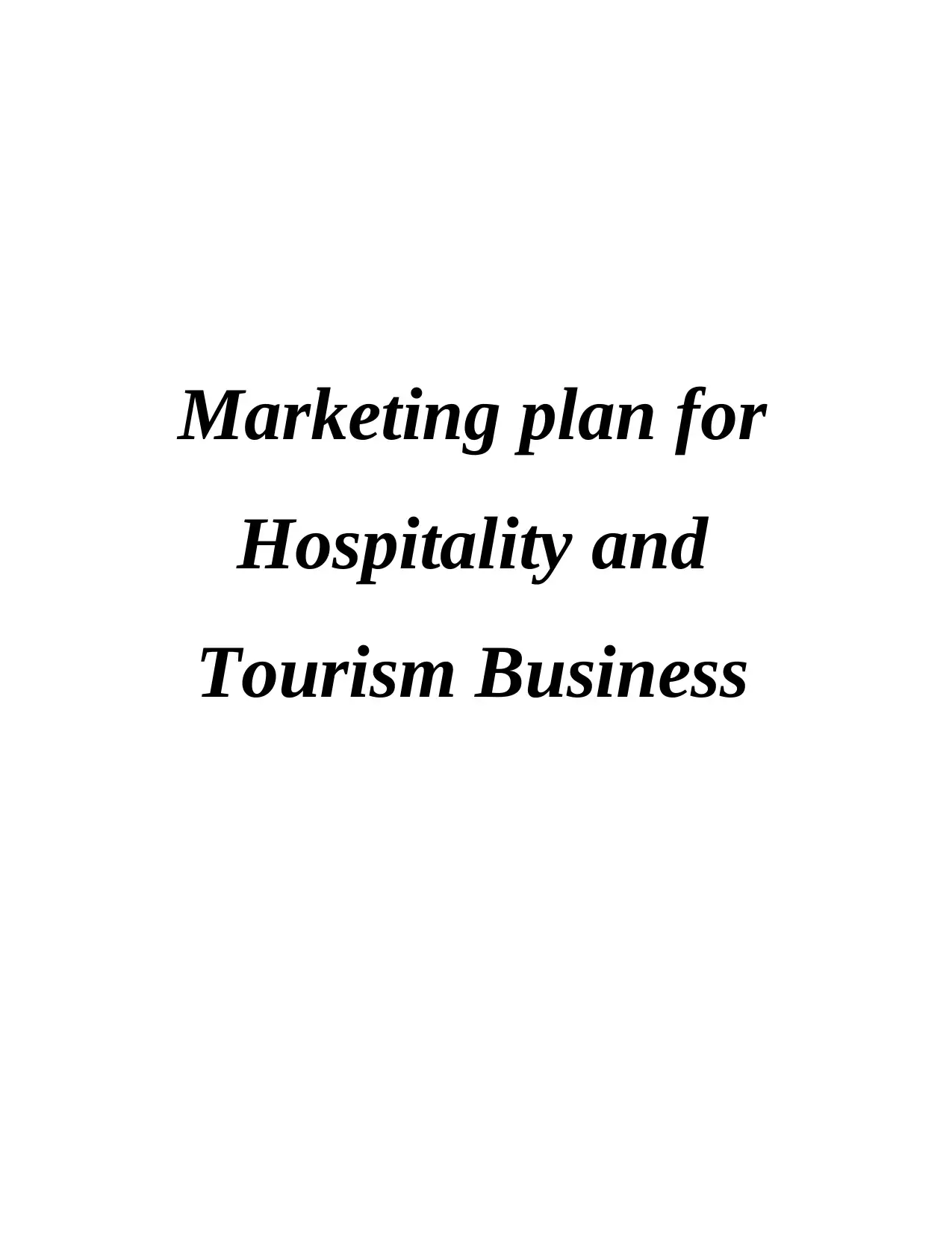
Marketing plan for
Hospitality and
Tourism Business
Hospitality and
Tourism Business
Paraphrase This Document
Need a fresh take? Get an instant paraphrase of this document with our AI Paraphraser
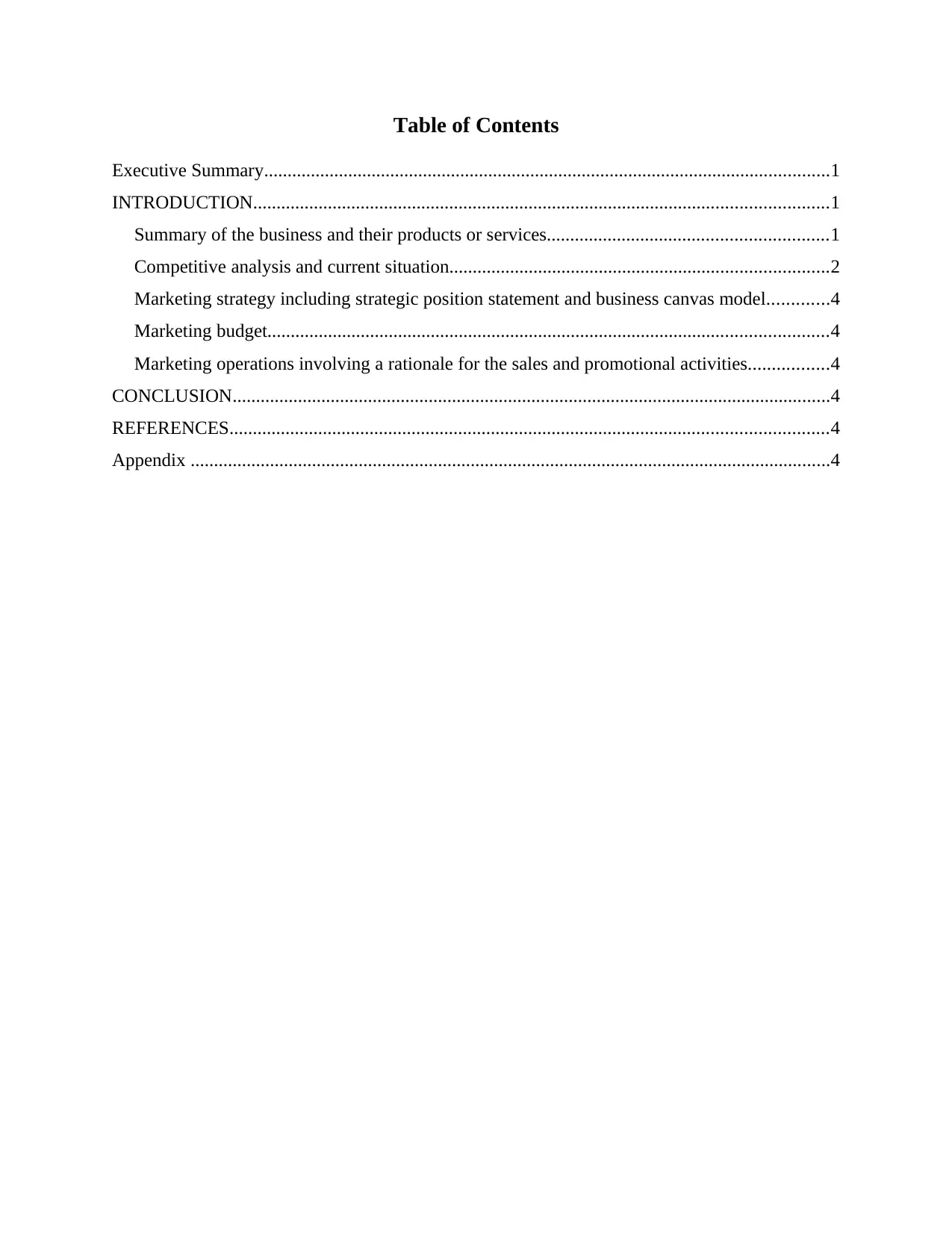
Table of Contents
Executive Summary.........................................................................................................................1
INTRODUCTION...........................................................................................................................1
Summary of the business and their products or services............................................................1
Competitive analysis and current situation.................................................................................2
Marketing strategy including strategic position statement and business canvas model.............4
Marketing budget........................................................................................................................4
Marketing operations involving a rationale for the sales and promotional activities.................4
CONCLUSION................................................................................................................................4
REFERENCES................................................................................................................................4
Appendix .........................................................................................................................................4
Executive Summary.........................................................................................................................1
INTRODUCTION...........................................................................................................................1
Summary of the business and their products or services............................................................1
Competitive analysis and current situation.................................................................................2
Marketing strategy including strategic position statement and business canvas model.............4
Marketing budget........................................................................................................................4
Marketing operations involving a rationale for the sales and promotional activities.................4
CONCLUSION................................................................................................................................4
REFERENCES................................................................................................................................4
Appendix .........................................................................................................................................4
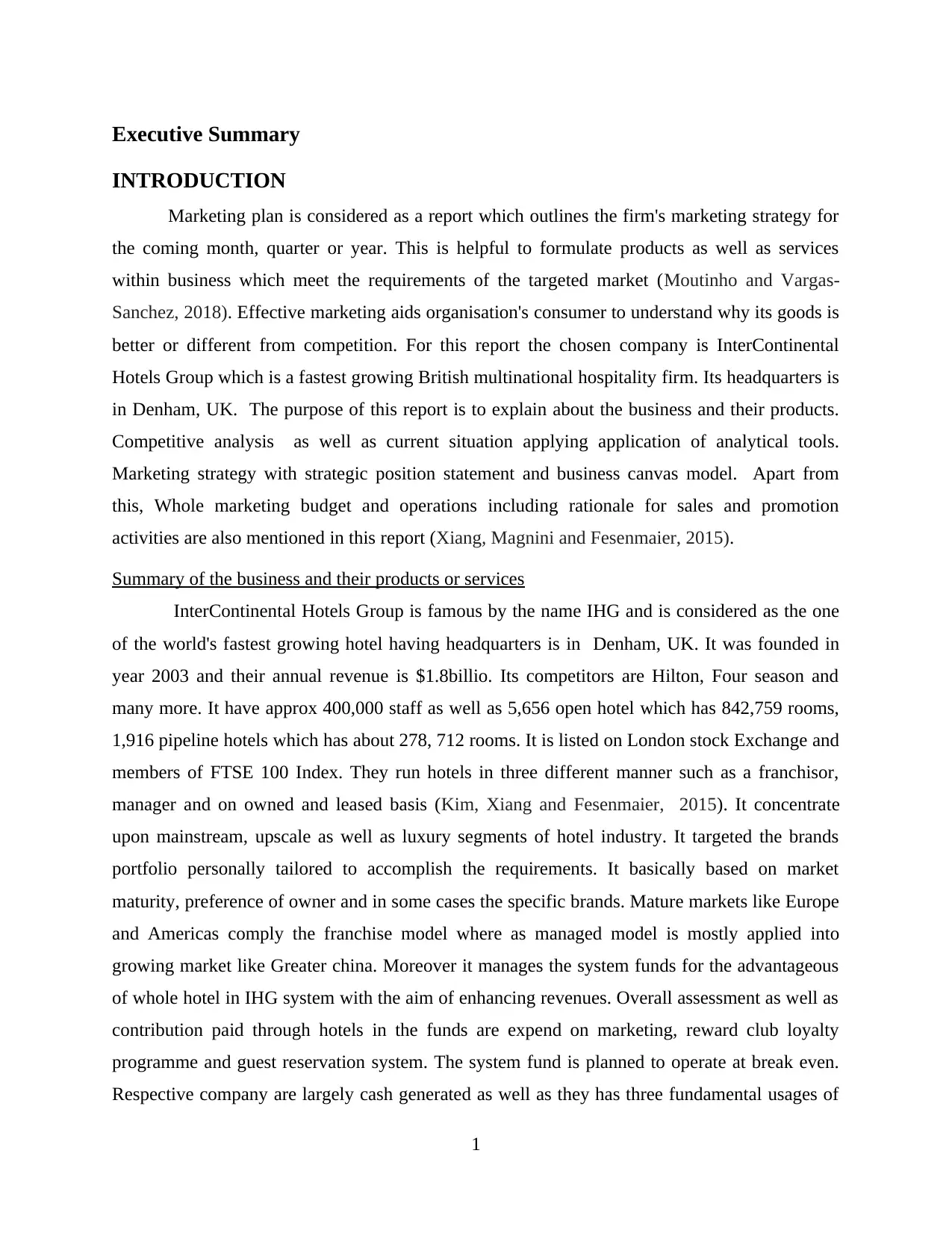
Executive Summary
INTRODUCTION
Marketing plan is considered as a report which outlines the firm's marketing strategy for
the coming month, quarter or year. This is helpful to formulate products as well as services
within business which meet the requirements of the targeted market (Moutinho and Vargas-
Sanchez, 2018). Effective marketing aids organisation's consumer to understand why its goods is
better or different from competition. For this report the chosen company is InterContinental
Hotels Group which is a fastest growing British multinational hospitality firm. Its headquarters is
in Denham, UK. The purpose of this report is to explain about the business and their products.
Competitive analysis as well as current situation applying application of analytical tools.
Marketing strategy with strategic position statement and business canvas model. Apart from
this, Whole marketing budget and operations including rationale for sales and promotion
activities are also mentioned in this report (Xiang, Magnini and Fesenmaier, 2015).
Summary of the business and their products or services
InterContinental Hotels Group is famous by the name IHG and is considered as the one
of the world's fastest growing hotel having headquarters is in Denham, UK. It was founded in
year 2003 and their annual revenue is $1.8billio. Its competitors are Hilton, Four season and
many more. It have approx 400,000 staff as well as 5,656 open hotel which has 842,759 rooms,
1,916 pipeline hotels which has about 278, 712 rooms. It is listed on London stock Exchange and
members of FTSE 100 Index. They run hotels in three different manner such as a franchisor,
manager and on owned and leased basis (Kim, Xiang and Fesenmaier, 2015). It concentrate
upon mainstream, upscale as well as luxury segments of hotel industry. It targeted the brands
portfolio personally tailored to accomplish the requirements. It basically based on market
maturity, preference of owner and in some cases the specific brands. Mature markets like Europe
and Americas comply the franchise model where as managed model is mostly applied into
growing market like Greater china. Moreover it manages the system funds for the advantageous
of whole hotel in IHG system with the aim of enhancing revenues. Overall assessment as well as
contribution paid through hotels in the funds are expend on marketing, reward club loyalty
programme and guest reservation system. The system fund is planned to operate at break even.
Respective company are largely cash generated as well as they has three fundamental usages of
1
INTRODUCTION
Marketing plan is considered as a report which outlines the firm's marketing strategy for
the coming month, quarter or year. This is helpful to formulate products as well as services
within business which meet the requirements of the targeted market (Moutinho and Vargas-
Sanchez, 2018). Effective marketing aids organisation's consumer to understand why its goods is
better or different from competition. For this report the chosen company is InterContinental
Hotels Group which is a fastest growing British multinational hospitality firm. Its headquarters is
in Denham, UK. The purpose of this report is to explain about the business and their products.
Competitive analysis as well as current situation applying application of analytical tools.
Marketing strategy with strategic position statement and business canvas model. Apart from
this, Whole marketing budget and operations including rationale for sales and promotion
activities are also mentioned in this report (Xiang, Magnini and Fesenmaier, 2015).
Summary of the business and their products or services
InterContinental Hotels Group is famous by the name IHG and is considered as the one
of the world's fastest growing hotel having headquarters is in Denham, UK. It was founded in
year 2003 and their annual revenue is $1.8billio. Its competitors are Hilton, Four season and
many more. It have approx 400,000 staff as well as 5,656 open hotel which has 842,759 rooms,
1,916 pipeline hotels which has about 278, 712 rooms. It is listed on London stock Exchange and
members of FTSE 100 Index. They run hotels in three different manner such as a franchisor,
manager and on owned and leased basis (Kim, Xiang and Fesenmaier, 2015). It concentrate
upon mainstream, upscale as well as luxury segments of hotel industry. It targeted the brands
portfolio personally tailored to accomplish the requirements. It basically based on market
maturity, preference of owner and in some cases the specific brands. Mature markets like Europe
and Americas comply the franchise model where as managed model is mostly applied into
growing market like Greater china. Moreover it manages the system funds for the advantageous
of whole hotel in IHG system with the aim of enhancing revenues. Overall assessment as well as
contribution paid through hotels in the funds are expend on marketing, reward club loyalty
programme and guest reservation system. The system fund is planned to operate at break even.
Respective company are largely cash generated as well as they has three fundamental usages of
1
⊘ This is a preview!⊘
Do you want full access?
Subscribe today to unlock all pages.

Trusted by 1+ million students worldwide
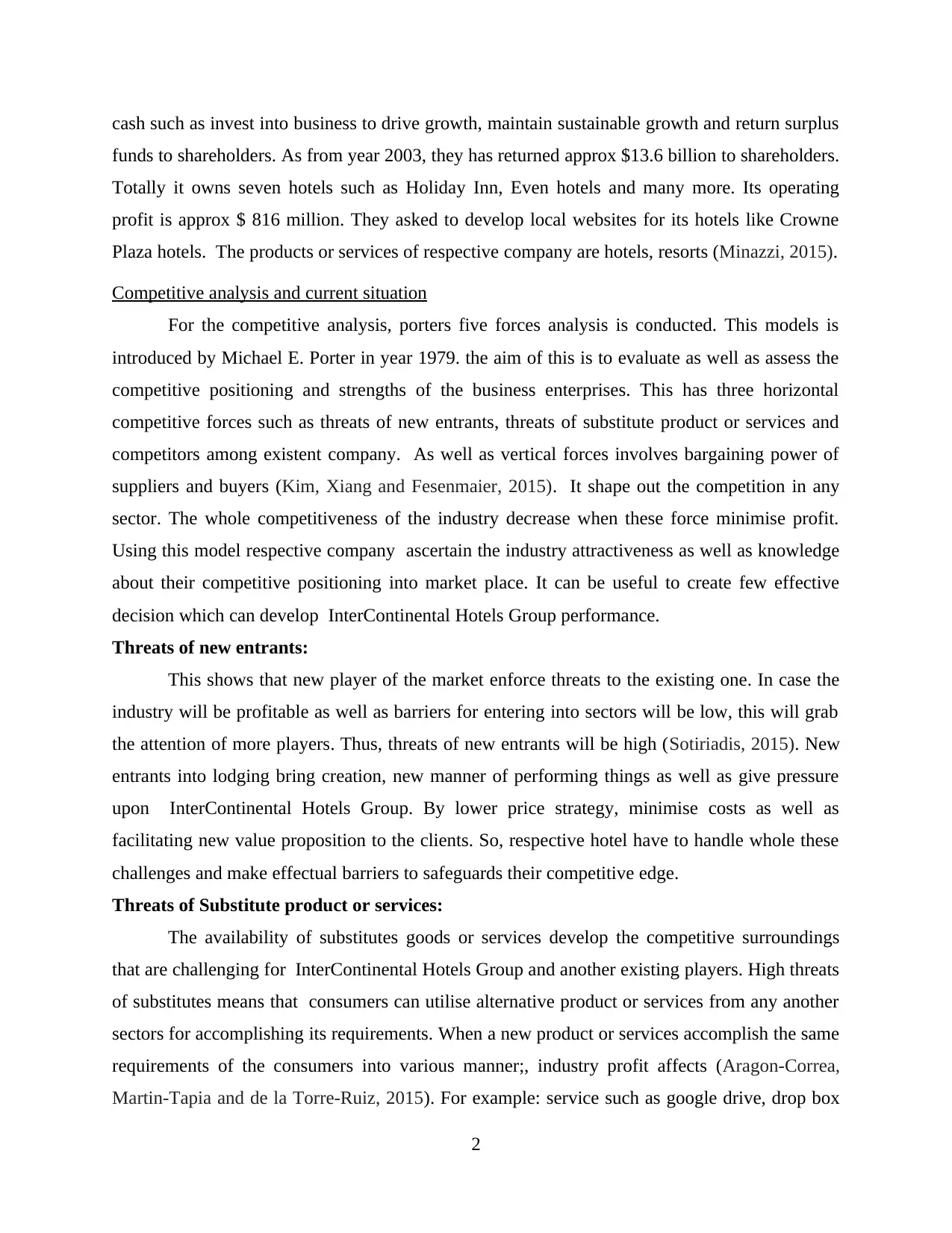
cash such as invest into business to drive growth, maintain sustainable growth and return surplus
funds to shareholders. As from year 2003, they has returned approx $13.6 billion to shareholders.
Totally it owns seven hotels such as Holiday Inn, Even hotels and many more. Its operating
profit is approx $ 816 million. They asked to develop local websites for its hotels like Crowne
Plaza hotels. The products or services of respective company are hotels, resorts (Minazzi, 2015).
Competitive analysis and current situation
For the competitive analysis, porters five forces analysis is conducted. This models is
introduced by Michael E. Porter in year 1979. the aim of this is to evaluate as well as assess the
competitive positioning and strengths of the business enterprises. This has three horizontal
competitive forces such as threats of new entrants, threats of substitute product or services and
competitors among existent company. As well as vertical forces involves bargaining power of
suppliers and buyers (Kim, Xiang and Fesenmaier, 2015). It shape out the competition in any
sector. The whole competitiveness of the industry decrease when these force minimise profit.
Using this model respective company ascertain the industry attractiveness as well as knowledge
about their competitive positioning into market place. It can be useful to create few effective
decision which can develop InterContinental Hotels Group performance.
Threats of new entrants:
This shows that new player of the market enforce threats to the existing one. In case the
industry will be profitable as well as barriers for entering into sectors will be low, this will grab
the attention of more players. Thus, threats of new entrants will be high (Sotiriadis, 2015). New
entrants into lodging bring creation, new manner of performing things as well as give pressure
upon InterContinental Hotels Group. By lower price strategy, minimise costs as well as
facilitating new value proposition to the clients. So, respective hotel have to handle whole these
challenges and make effectual barriers to safeguards their competitive edge.
Threats of Substitute product or services:
The availability of substitutes goods or services develop the competitive surroundings
that are challenging for InterContinental Hotels Group and another existing players. High threats
of substitutes means that consumers can utilise alternative product or services from any another
sectors for accomplishing its requirements. When a new product or services accomplish the same
requirements of the consumers into various manner;, industry profit affects (Aragon-Correa,
Martin-Tapia and de la Torre-Ruiz, 2015). For example: service such as google drive, drop box
2
funds to shareholders. As from year 2003, they has returned approx $13.6 billion to shareholders.
Totally it owns seven hotels such as Holiday Inn, Even hotels and many more. Its operating
profit is approx $ 816 million. They asked to develop local websites for its hotels like Crowne
Plaza hotels. The products or services of respective company are hotels, resorts (Minazzi, 2015).
Competitive analysis and current situation
For the competitive analysis, porters five forces analysis is conducted. This models is
introduced by Michael E. Porter in year 1979. the aim of this is to evaluate as well as assess the
competitive positioning and strengths of the business enterprises. This has three horizontal
competitive forces such as threats of new entrants, threats of substitute product or services and
competitors among existent company. As well as vertical forces involves bargaining power of
suppliers and buyers (Kim, Xiang and Fesenmaier, 2015). It shape out the competition in any
sector. The whole competitiveness of the industry decrease when these force minimise profit.
Using this model respective company ascertain the industry attractiveness as well as knowledge
about their competitive positioning into market place. It can be useful to create few effective
decision which can develop InterContinental Hotels Group performance.
Threats of new entrants:
This shows that new player of the market enforce threats to the existing one. In case the
industry will be profitable as well as barriers for entering into sectors will be low, this will grab
the attention of more players. Thus, threats of new entrants will be high (Sotiriadis, 2015). New
entrants into lodging bring creation, new manner of performing things as well as give pressure
upon InterContinental Hotels Group. By lower price strategy, minimise costs as well as
facilitating new value proposition to the clients. So, respective hotel have to handle whole these
challenges and make effectual barriers to safeguards their competitive edge.
Threats of Substitute product or services:
The availability of substitutes goods or services develop the competitive surroundings
that are challenging for InterContinental Hotels Group and another existing players. High threats
of substitutes means that consumers can utilise alternative product or services from any another
sectors for accomplishing its requirements. When a new product or services accomplish the same
requirements of the consumers into various manner;, industry profit affects (Aragon-Correa,
Martin-Tapia and de la Torre-Ruiz, 2015). For example: service such as google drive, drop box
2
Paraphrase This Document
Need a fresh take? Get an instant paraphrase of this document with our AI Paraphraser
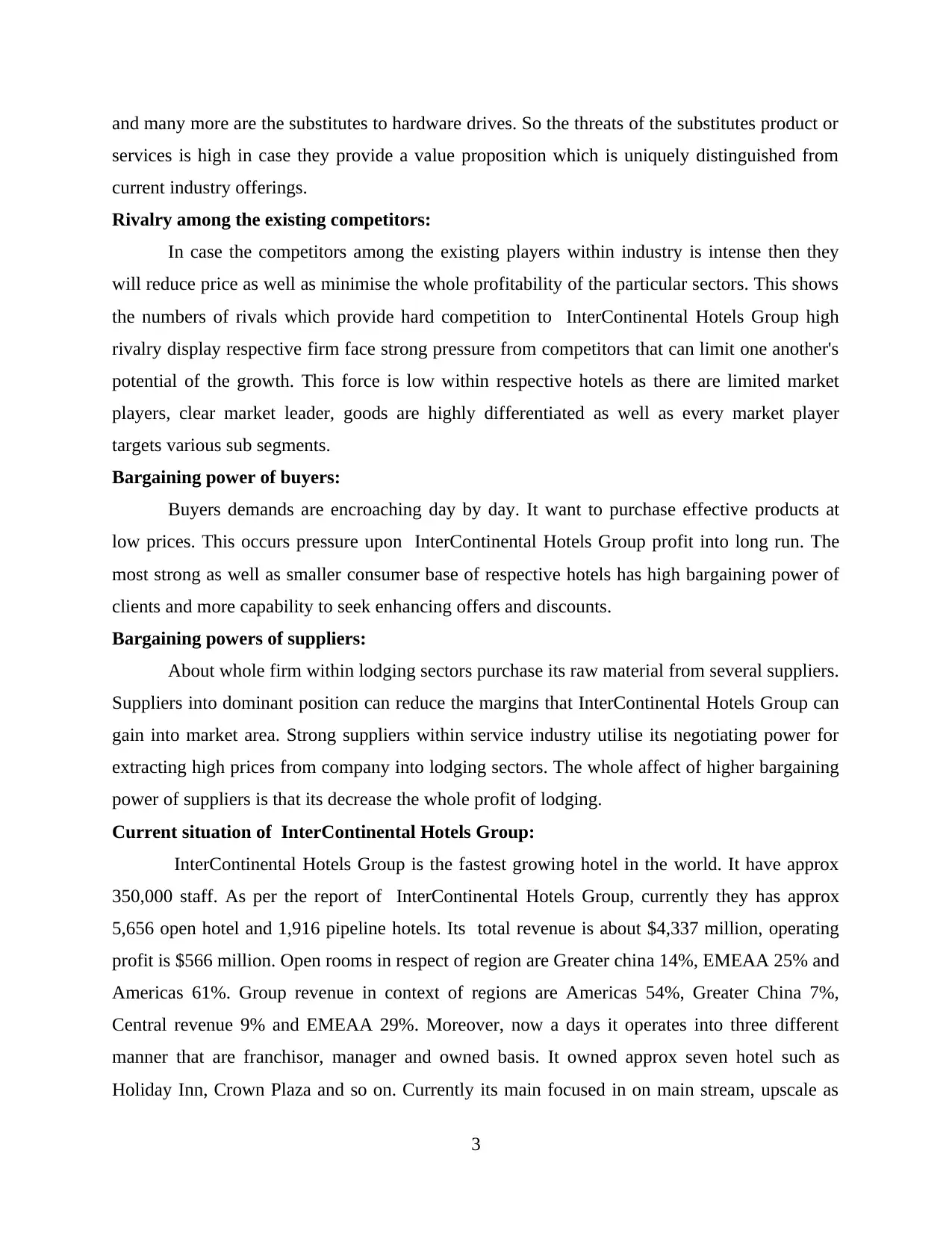
and many more are the substitutes to hardware drives. So the threats of the substitutes product or
services is high in case they provide a value proposition which is uniquely distinguished from
current industry offerings.
Rivalry among the existing competitors:
In case the competitors among the existing players within industry is intense then they
will reduce price as well as minimise the whole profitability of the particular sectors. This shows
the numbers of rivals which provide hard competition to InterContinental Hotels Group high
rivalry display respective firm face strong pressure from competitors that can limit one another's
potential of the growth. This force is low within respective hotels as there are limited market
players, clear market leader, goods are highly differentiated as well as every market player
targets various sub segments.
Bargaining power of buyers:
Buyers demands are encroaching day by day. It want to purchase effective products at
low prices. This occurs pressure upon InterContinental Hotels Group profit into long run. The
most strong as well as smaller consumer base of respective hotels has high bargaining power of
clients and more capability to seek enhancing offers and discounts.
Bargaining powers of suppliers:
About whole firm within lodging sectors purchase its raw material from several suppliers.
Suppliers into dominant position can reduce the margins that InterContinental Hotels Group can
gain into market area. Strong suppliers within service industry utilise its negotiating power for
extracting high prices from company into lodging sectors. The whole affect of higher bargaining
power of suppliers is that its decrease the whole profit of lodging.
Current situation of InterContinental Hotels Group:
InterContinental Hotels Group is the fastest growing hotel in the world. It have approx
350,000 staff. As per the report of InterContinental Hotels Group, currently they has approx
5,656 open hotel and 1,916 pipeline hotels. Its total revenue is about $4,337 million, operating
profit is $566 million. Open rooms in respect of region are Greater china 14%, EMEAA 25% and
Americas 61%. Group revenue in context of regions are Americas 54%, Greater China 7%,
Central revenue 9% and EMEAA 29%. Moreover, now a days it operates into three different
manner that are franchisor, manager and owned basis. It owned approx seven hotel such as
Holiday Inn, Crown Plaza and so on. Currently its main focused in on main stream, upscale as
3
services is high in case they provide a value proposition which is uniquely distinguished from
current industry offerings.
Rivalry among the existing competitors:
In case the competitors among the existing players within industry is intense then they
will reduce price as well as minimise the whole profitability of the particular sectors. This shows
the numbers of rivals which provide hard competition to InterContinental Hotels Group high
rivalry display respective firm face strong pressure from competitors that can limit one another's
potential of the growth. This force is low within respective hotels as there are limited market
players, clear market leader, goods are highly differentiated as well as every market player
targets various sub segments.
Bargaining power of buyers:
Buyers demands are encroaching day by day. It want to purchase effective products at
low prices. This occurs pressure upon InterContinental Hotels Group profit into long run. The
most strong as well as smaller consumer base of respective hotels has high bargaining power of
clients and more capability to seek enhancing offers and discounts.
Bargaining powers of suppliers:
About whole firm within lodging sectors purchase its raw material from several suppliers.
Suppliers into dominant position can reduce the margins that InterContinental Hotels Group can
gain into market area. Strong suppliers within service industry utilise its negotiating power for
extracting high prices from company into lodging sectors. The whole affect of higher bargaining
power of suppliers is that its decrease the whole profit of lodging.
Current situation of InterContinental Hotels Group:
InterContinental Hotels Group is the fastest growing hotel in the world. It have approx
350,000 staff. As per the report of InterContinental Hotels Group, currently they has approx
5,656 open hotel and 1,916 pipeline hotels. Its total revenue is about $4,337 million, operating
profit is $566 million. Open rooms in respect of region are Greater china 14%, EMEAA 25% and
Americas 61%. Group revenue in context of regions are Americas 54%, Greater China 7%,
Central revenue 9% and EMEAA 29%. Moreover, now a days it operates into three different
manner that are franchisor, manager and owned basis. It owned approx seven hotel such as
Holiday Inn, Crown Plaza and so on. Currently its main focused in on main stream, upscale as
3
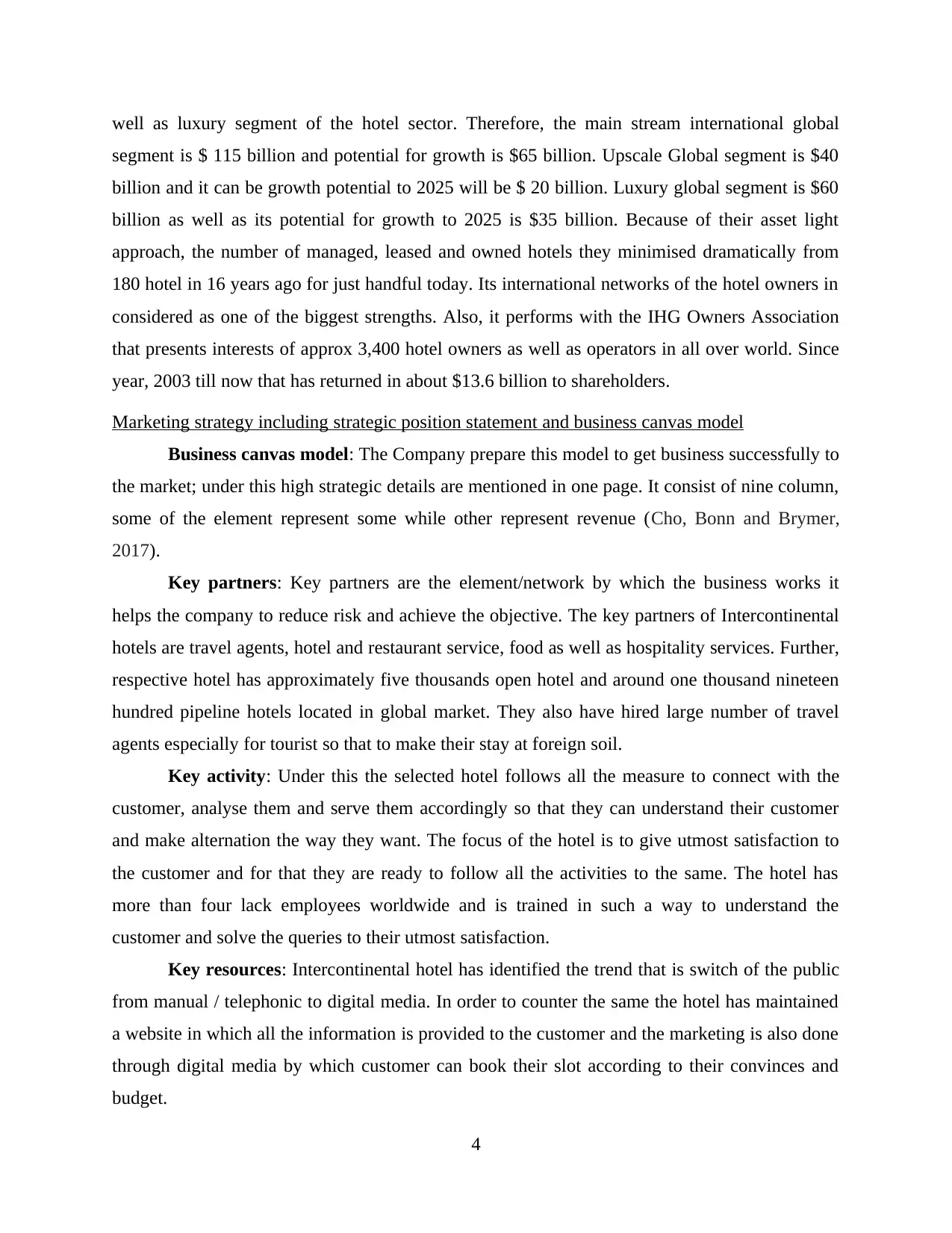
well as luxury segment of the hotel sector. Therefore, the main stream international global
segment is $ 115 billion and potential for growth is $65 billion. Upscale Global segment is $40
billion and it can be growth potential to 2025 will be $ 20 billion. Luxury global segment is $60
billion as well as its potential for growth to 2025 is $35 billion. Because of their asset light
approach, the number of managed, leased and owned hotels they minimised dramatically from
180 hotel in 16 years ago for just handful today. Its international networks of the hotel owners in
considered as one of the biggest strengths. Also, it performs with the IHG Owners Association
that presents interests of approx 3,400 hotel owners as well as operators in all over world. Since
year, 2003 till now that has returned in about $13.6 billion to shareholders.
Marketing strategy including strategic position statement and business canvas model
Business canvas model: The Company prepare this model to get business successfully to
the market; under this high strategic details are mentioned in one page. It consist of nine column,
some of the element represent some while other represent revenue (Cho, Bonn and Brymer,
2017).
Key partners: Key partners are the element/network by which the business works it
helps the company to reduce risk and achieve the objective. The key partners of Intercontinental
hotels are travel agents, hotel and restaurant service, food as well as hospitality services. Further,
respective hotel has approximately five thousands open hotel and around one thousand nineteen
hundred pipeline hotels located in global market. They also have hired large number of travel
agents especially for tourist so that to make their stay at foreign soil.
Key activity: Under this the selected hotel follows all the measure to connect with the
customer, analyse them and serve them accordingly so that they can understand their customer
and make alternation the way they want. The focus of the hotel is to give utmost satisfaction to
the customer and for that they are ready to follow all the activities to the same. The hotel has
more than four lack employees worldwide and is trained in such a way to understand the
customer and solve the queries to their utmost satisfaction.
Key resources: Intercontinental hotel has identified the trend that is switch of the public
from manual / telephonic to digital media. In order to counter the same the hotel has maintained
a website in which all the information is provided to the customer and the marketing is also done
through digital media by which customer can book their slot according to their convinces and
budget.
4
segment is $ 115 billion and potential for growth is $65 billion. Upscale Global segment is $40
billion and it can be growth potential to 2025 will be $ 20 billion. Luxury global segment is $60
billion as well as its potential for growth to 2025 is $35 billion. Because of their asset light
approach, the number of managed, leased and owned hotels they minimised dramatically from
180 hotel in 16 years ago for just handful today. Its international networks of the hotel owners in
considered as one of the biggest strengths. Also, it performs with the IHG Owners Association
that presents interests of approx 3,400 hotel owners as well as operators in all over world. Since
year, 2003 till now that has returned in about $13.6 billion to shareholders.
Marketing strategy including strategic position statement and business canvas model
Business canvas model: The Company prepare this model to get business successfully to
the market; under this high strategic details are mentioned in one page. It consist of nine column,
some of the element represent some while other represent revenue (Cho, Bonn and Brymer,
2017).
Key partners: Key partners are the element/network by which the business works it
helps the company to reduce risk and achieve the objective. The key partners of Intercontinental
hotels are travel agents, hotel and restaurant service, food as well as hospitality services. Further,
respective hotel has approximately five thousands open hotel and around one thousand nineteen
hundred pipeline hotels located in global market. They also have hired large number of travel
agents especially for tourist so that to make their stay at foreign soil.
Key activity: Under this the selected hotel follows all the measure to connect with the
customer, analyse them and serve them accordingly so that they can understand their customer
and make alternation the way they want. The focus of the hotel is to give utmost satisfaction to
the customer and for that they are ready to follow all the activities to the same. The hotel has
more than four lack employees worldwide and is trained in such a way to understand the
customer and solve the queries to their utmost satisfaction.
Key resources: Intercontinental hotel has identified the trend that is switch of the public
from manual / telephonic to digital media. In order to counter the same the hotel has maintained
a website in which all the information is provided to the customer and the marketing is also done
through digital media by which customer can book their slot according to their convinces and
budget.
4
⊘ This is a preview!⊘
Do you want full access?
Subscribe today to unlock all pages.

Trusted by 1+ million students worldwide
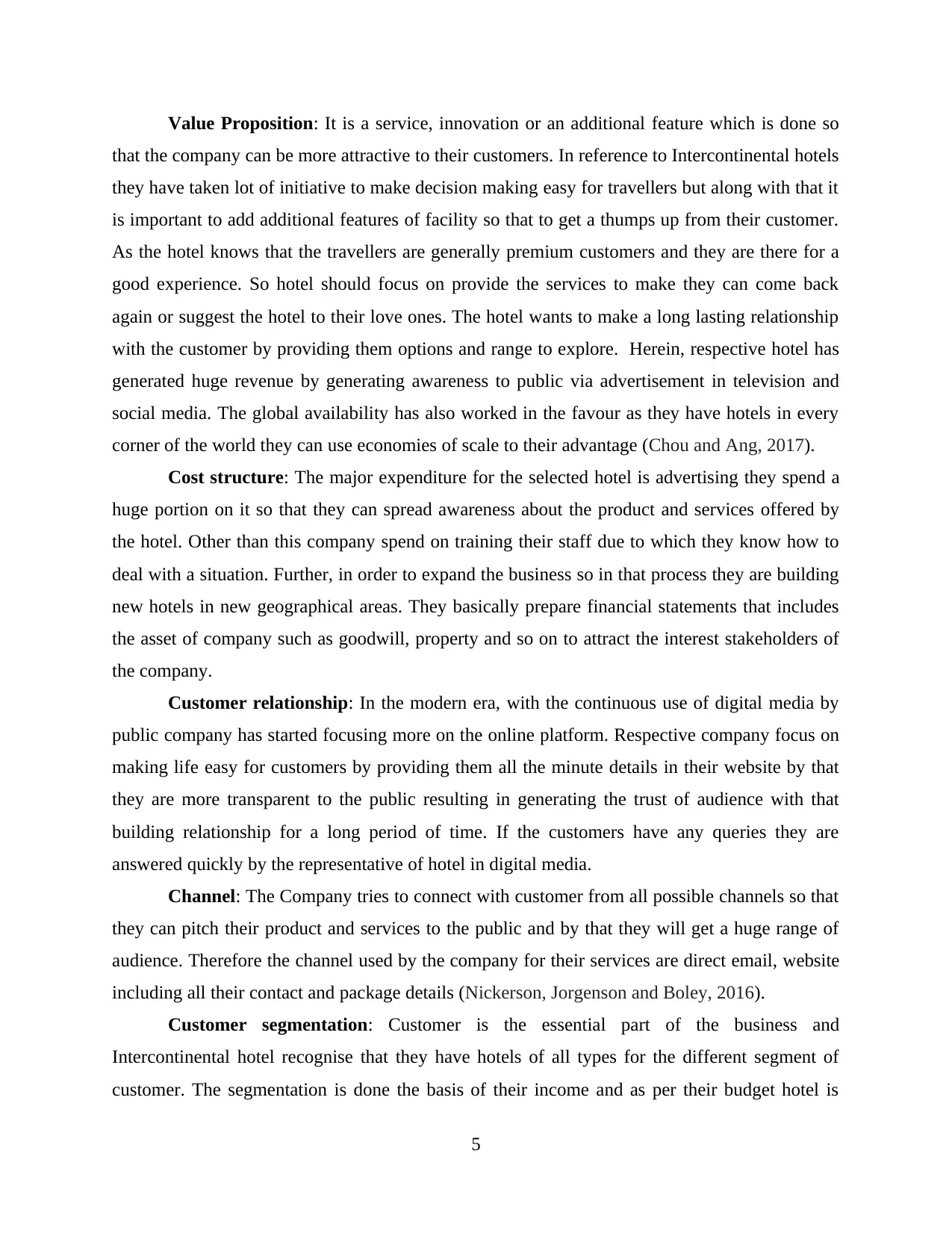
Value Proposition: It is a service, innovation or an additional feature which is done so
that the company can be more attractive to their customers. In reference to Intercontinental hotels
they have taken lot of initiative to make decision making easy for travellers but along with that it
is important to add additional features of facility so that to get a thumps up from their customer.
As the hotel knows that the travellers are generally premium customers and they are there for a
good experience. So hotel should focus on provide the services to make they can come back
again or suggest the hotel to their love ones. The hotel wants to make a long lasting relationship
with the customer by providing them options and range to explore. Herein, respective hotel has
generated huge revenue by generating awareness to public via advertisement in television and
social media. The global availability has also worked in the favour as they have hotels in every
corner of the world they can use economies of scale to their advantage (Chou and Ang, 2017).
Cost structure: The major expenditure for the selected hotel is advertising they spend a
huge portion on it so that they can spread awareness about the product and services offered by
the hotel. Other than this company spend on training their staff due to which they know how to
deal with a situation. Further, in order to expand the business so in that process they are building
new hotels in new geographical areas. They basically prepare financial statements that includes
the asset of company such as goodwill, property and so on to attract the interest stakeholders of
the company.
Customer relationship: In the modern era, with the continuous use of digital media by
public company has started focusing more on the online platform. Respective company focus on
making life easy for customers by providing them all the minute details in their website by that
they are more transparent to the public resulting in generating the trust of audience with that
building relationship for a long period of time. If the customers have any queries they are
answered quickly by the representative of hotel in digital media.
Channel: The Company tries to connect with customer from all possible channels so that
they can pitch their product and services to the public and by that they will get a huge range of
audience. Therefore the channel used by the company for their services are direct email, website
including all their contact and package details (Nickerson, Jorgenson and Boley, 2016).
Customer segmentation: Customer is the essential part of the business and
Intercontinental hotel recognise that they have hotels of all types for the different segment of
customer. The segmentation is done the basis of their income and as per their budget hotel is
5
that the company can be more attractive to their customers. In reference to Intercontinental hotels
they have taken lot of initiative to make decision making easy for travellers but along with that it
is important to add additional features of facility so that to get a thumps up from their customer.
As the hotel knows that the travellers are generally premium customers and they are there for a
good experience. So hotel should focus on provide the services to make they can come back
again or suggest the hotel to their love ones. The hotel wants to make a long lasting relationship
with the customer by providing them options and range to explore. Herein, respective hotel has
generated huge revenue by generating awareness to public via advertisement in television and
social media. The global availability has also worked in the favour as they have hotels in every
corner of the world they can use economies of scale to their advantage (Chou and Ang, 2017).
Cost structure: The major expenditure for the selected hotel is advertising they spend a
huge portion on it so that they can spread awareness about the product and services offered by
the hotel. Other than this company spend on training their staff due to which they know how to
deal with a situation. Further, in order to expand the business so in that process they are building
new hotels in new geographical areas. They basically prepare financial statements that includes
the asset of company such as goodwill, property and so on to attract the interest stakeholders of
the company.
Customer relationship: In the modern era, with the continuous use of digital media by
public company has started focusing more on the online platform. Respective company focus on
making life easy for customers by providing them all the minute details in their website by that
they are more transparent to the public resulting in generating the trust of audience with that
building relationship for a long period of time. If the customers have any queries they are
answered quickly by the representative of hotel in digital media.
Channel: The Company tries to connect with customer from all possible channels so that
they can pitch their product and services to the public and by that they will get a huge range of
audience. Therefore the channel used by the company for their services are direct email, website
including all their contact and package details (Nickerson, Jorgenson and Boley, 2016).
Customer segmentation: Customer is the essential part of the business and
Intercontinental hotel recognise that they have hotels of all types for the different segment of
customer. The segmentation is done the basis of their income and as per their budget hotel is
5
Paraphrase This Document
Need a fresh take? Get an instant paraphrase of this document with our AI Paraphraser
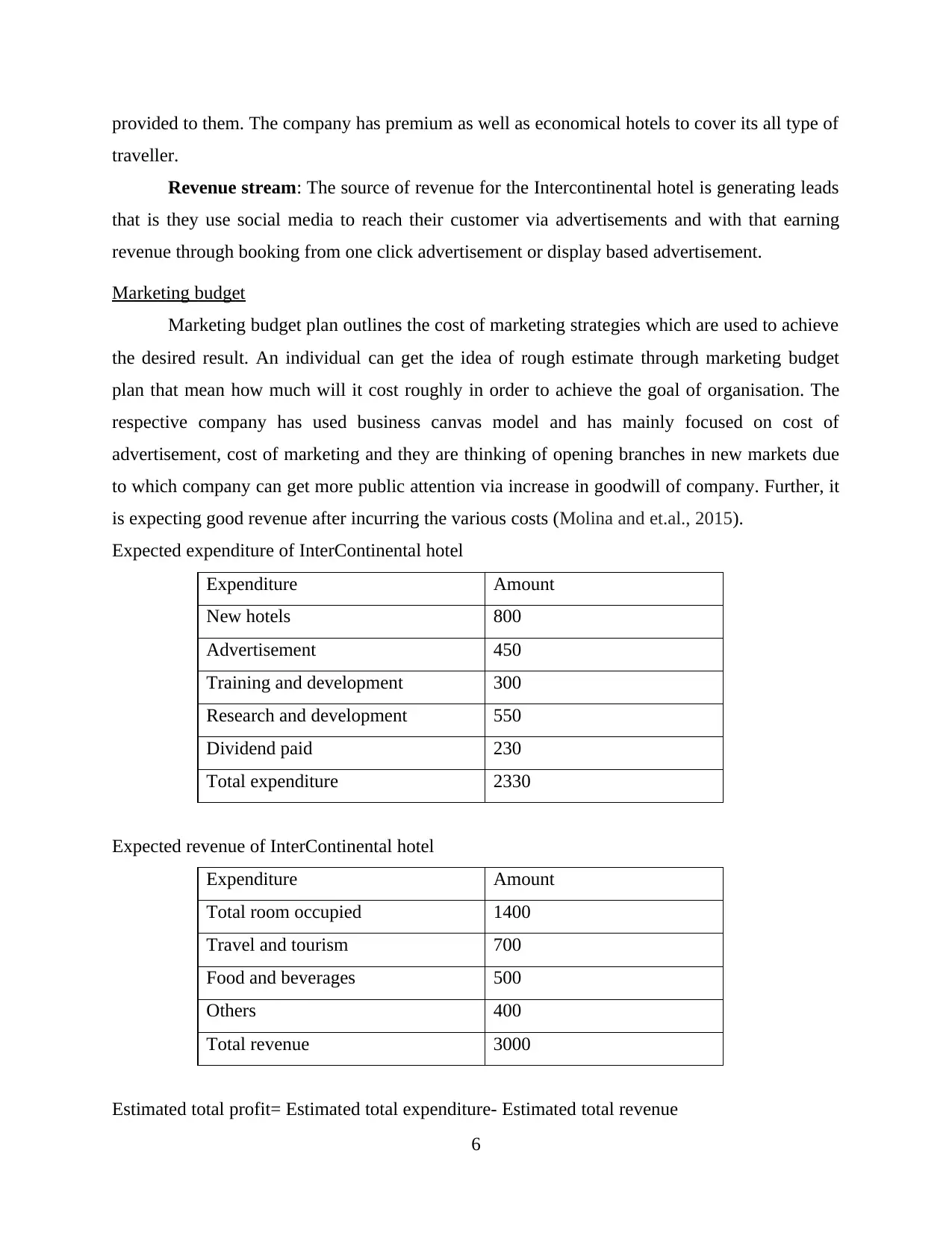
provided to them. The company has premium as well as economical hotels to cover its all type of
traveller.
Revenue stream: The source of revenue for the Intercontinental hotel is generating leads
that is they use social media to reach their customer via advertisements and with that earning
revenue through booking from one click advertisement or display based advertisement.
Marketing budget
Marketing budget plan outlines the cost of marketing strategies which are used to achieve
the desired result. An individual can get the idea of rough estimate through marketing budget
plan that mean how much will it cost roughly in order to achieve the goal of organisation. The
respective company has used business canvas model and has mainly focused on cost of
advertisement, cost of marketing and they are thinking of opening branches in new markets due
to which company can get more public attention via increase in goodwill of company. Further, it
is expecting good revenue after incurring the various costs (Molina and et.al., 2015).
Expected expenditure of InterContinental hotel
Expenditure Amount
New hotels 800
Advertisement 450
Training and development 300
Research and development 550
Dividend paid 230
Total expenditure 2330
Expected revenue of InterContinental hotel
Expenditure Amount
Total room occupied 1400
Travel and tourism 700
Food and beverages 500
Others 400
Total revenue 3000
Estimated total profit= Estimated total expenditure- Estimated total revenue
6
traveller.
Revenue stream: The source of revenue for the Intercontinental hotel is generating leads
that is they use social media to reach their customer via advertisements and with that earning
revenue through booking from one click advertisement or display based advertisement.
Marketing budget
Marketing budget plan outlines the cost of marketing strategies which are used to achieve
the desired result. An individual can get the idea of rough estimate through marketing budget
plan that mean how much will it cost roughly in order to achieve the goal of organisation. The
respective company has used business canvas model and has mainly focused on cost of
advertisement, cost of marketing and they are thinking of opening branches in new markets due
to which company can get more public attention via increase in goodwill of company. Further, it
is expecting good revenue after incurring the various costs (Molina and et.al., 2015).
Expected expenditure of InterContinental hotel
Expenditure Amount
New hotels 800
Advertisement 450
Training and development 300
Research and development 550
Dividend paid 230
Total expenditure 2330
Expected revenue of InterContinental hotel
Expenditure Amount
Total room occupied 1400
Travel and tourism 700
Food and beverages 500
Others 400
Total revenue 3000
Estimated total profit= Estimated total expenditure- Estimated total revenue
6
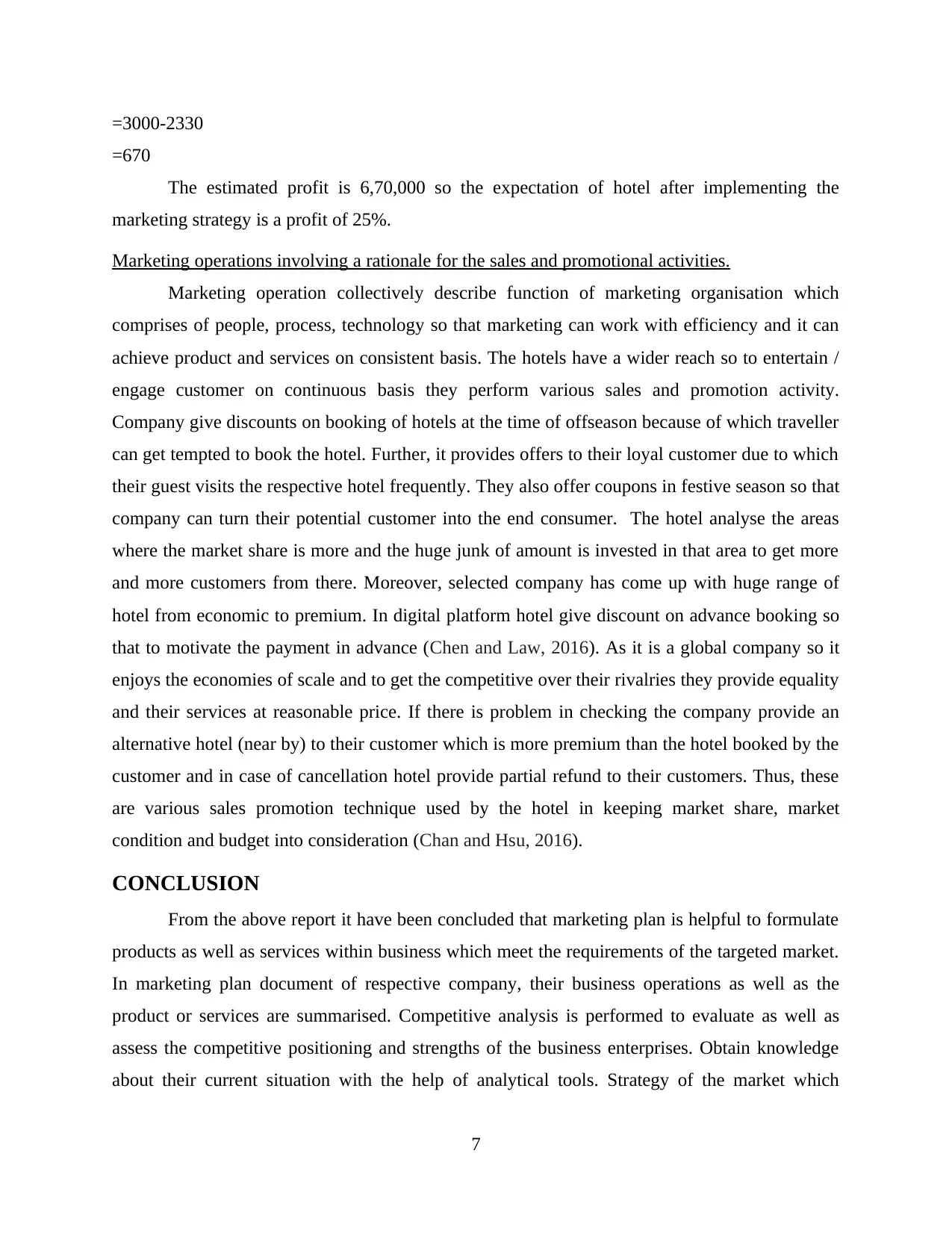
=3000-2330
=670
The estimated profit is 6,70,000 so the expectation of hotel after implementing the
marketing strategy is a profit of 25%.
Marketing operations involving a rationale for the sales and promotional activities.
Marketing operation collectively describe function of marketing organisation which
comprises of people, process, technology so that marketing can work with efficiency and it can
achieve product and services on consistent basis. The hotels have a wider reach so to entertain /
engage customer on continuous basis they perform various sales and promotion activity.
Company give discounts on booking of hotels at the time of offseason because of which traveller
can get tempted to book the hotel. Further, it provides offers to their loyal customer due to which
their guest visits the respective hotel frequently. They also offer coupons in festive season so that
company can turn their potential customer into the end consumer. The hotel analyse the areas
where the market share is more and the huge junk of amount is invested in that area to get more
and more customers from there. Moreover, selected company has come up with huge range of
hotel from economic to premium. In digital platform hotel give discount on advance booking so
that to motivate the payment in advance (Chen and Law, 2016). As it is a global company so it
enjoys the economies of scale and to get the competitive over their rivalries they provide equality
and their services at reasonable price. If there is problem in checking the company provide an
alternative hotel (near by) to their customer which is more premium than the hotel booked by the
customer and in case of cancellation hotel provide partial refund to their customers. Thus, these
are various sales promotion technique used by the hotel in keeping market share, market
condition and budget into consideration (Chan and Hsu, 2016).
CONCLUSION
From the above report it have been concluded that marketing plan is helpful to formulate
products as well as services within business which meet the requirements of the targeted market.
In marketing plan document of respective company, their business operations as well as the
product or services are summarised. Competitive analysis is performed to evaluate as well as
assess the competitive positioning and strengths of the business enterprises. Obtain knowledge
about their current situation with the help of analytical tools. Strategy of the market which
7
=670
The estimated profit is 6,70,000 so the expectation of hotel after implementing the
marketing strategy is a profit of 25%.
Marketing operations involving a rationale for the sales and promotional activities.
Marketing operation collectively describe function of marketing organisation which
comprises of people, process, technology so that marketing can work with efficiency and it can
achieve product and services on consistent basis. The hotels have a wider reach so to entertain /
engage customer on continuous basis they perform various sales and promotion activity.
Company give discounts on booking of hotels at the time of offseason because of which traveller
can get tempted to book the hotel. Further, it provides offers to their loyal customer due to which
their guest visits the respective hotel frequently. They also offer coupons in festive season so that
company can turn their potential customer into the end consumer. The hotel analyse the areas
where the market share is more and the huge junk of amount is invested in that area to get more
and more customers from there. Moreover, selected company has come up with huge range of
hotel from economic to premium. In digital platform hotel give discount on advance booking so
that to motivate the payment in advance (Chen and Law, 2016). As it is a global company so it
enjoys the economies of scale and to get the competitive over their rivalries they provide equality
and their services at reasonable price. If there is problem in checking the company provide an
alternative hotel (near by) to their customer which is more premium than the hotel booked by the
customer and in case of cancellation hotel provide partial refund to their customers. Thus, these
are various sales promotion technique used by the hotel in keeping market share, market
condition and budget into consideration (Chan and Hsu, 2016).
CONCLUSION
From the above report it have been concluded that marketing plan is helpful to formulate
products as well as services within business which meet the requirements of the targeted market.
In marketing plan document of respective company, their business operations as well as the
product or services are summarised. Competitive analysis is performed to evaluate as well as
assess the competitive positioning and strengths of the business enterprises. Obtain knowledge
about their current situation with the help of analytical tools. Strategy of the market which
7
⊘ This is a preview!⊘
Do you want full access?
Subscribe today to unlock all pages.

Trusted by 1+ million students worldwide
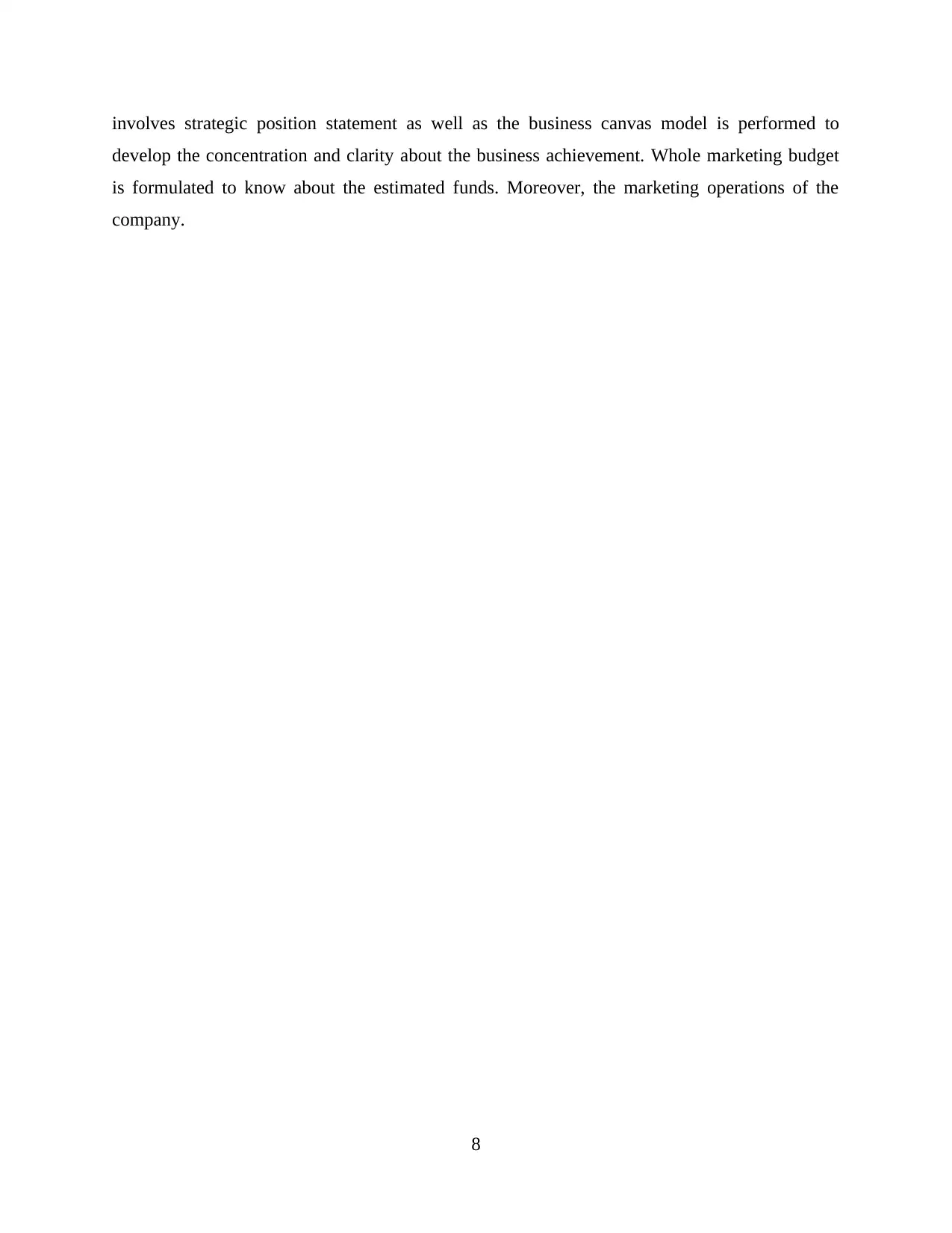
involves strategic position statement as well as the business canvas model is performed to
develop the concentration and clarity about the business achievement. Whole marketing budget
is formulated to know about the estimated funds. Moreover, the marketing operations of the
company.
8
develop the concentration and clarity about the business achievement. Whole marketing budget
is formulated to know about the estimated funds. Moreover, the marketing operations of the
company.
8
Paraphrase This Document
Need a fresh take? Get an instant paraphrase of this document with our AI Paraphraser
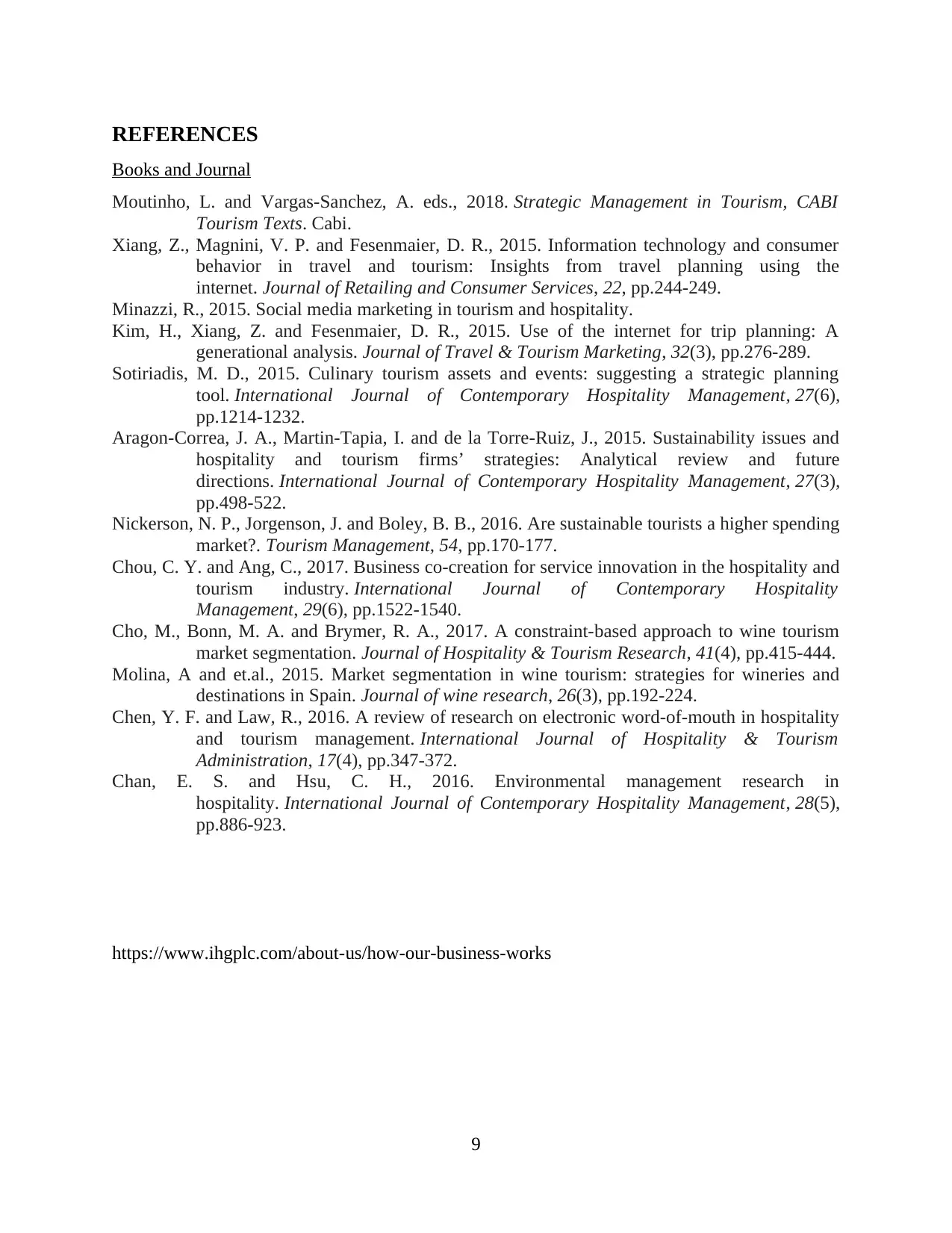
REFERENCES
Books and Journal
Moutinho, L. and Vargas-Sanchez, A. eds., 2018. Strategic Management in Tourism, CABI
Tourism Texts. Cabi.
Xiang, Z., Magnini, V. P. and Fesenmaier, D. R., 2015. Information technology and consumer
behavior in travel and tourism: Insights from travel planning using the
internet. Journal of Retailing and Consumer Services, 22, pp.244-249.
Minazzi, R., 2015. Social media marketing in tourism and hospitality.
Kim, H., Xiang, Z. and Fesenmaier, D. R., 2015. Use of the internet for trip planning: A
generational analysis. Journal of Travel & Tourism Marketing, 32(3), pp.276-289.
Sotiriadis, M. D., 2015. Culinary tourism assets and events: suggesting a strategic planning
tool. International Journal of Contemporary Hospitality Management, 27(6),
pp.1214-1232.
Aragon-Correa, J. A., Martin-Tapia, I. and de la Torre-Ruiz, J., 2015. Sustainability issues and
hospitality and tourism firms’ strategies: Analytical review and future
directions. International Journal of Contemporary Hospitality Management, 27(3),
pp.498-522.
Nickerson, N. P., Jorgenson, J. and Boley, B. B., 2016. Are sustainable tourists a higher spending
market?. Tourism Management, 54, pp.170-177.
Chou, C. Y. and Ang, C., 2017. Business co-creation for service innovation in the hospitality and
tourism industry. International Journal of Contemporary Hospitality
Management, 29(6), pp.1522-1540.
Cho, M., Bonn, M. A. and Brymer, R. A., 2017. A constraint-based approach to wine tourism
market segmentation. Journal of Hospitality & Tourism Research, 41(4), pp.415-444.
Molina, A and et.al., 2015. Market segmentation in wine tourism: strategies for wineries and
destinations in Spain. Journal of wine research, 26(3), pp.192-224.
Chen, Y. F. and Law, R., 2016. A review of research on electronic word-of-mouth in hospitality
and tourism management. International Journal of Hospitality & Tourism
Administration, 17(4), pp.347-372.
Chan, E. S. and Hsu, C. H., 2016. Environmental management research in
hospitality. International Journal of Contemporary Hospitality Management, 28(5),
pp.886-923.
https://www.ihgplc.com/about-us/how-our-business-works
9
Books and Journal
Moutinho, L. and Vargas-Sanchez, A. eds., 2018. Strategic Management in Tourism, CABI
Tourism Texts. Cabi.
Xiang, Z., Magnini, V. P. and Fesenmaier, D. R., 2015. Information technology and consumer
behavior in travel and tourism: Insights from travel planning using the
internet. Journal of Retailing and Consumer Services, 22, pp.244-249.
Minazzi, R., 2015. Social media marketing in tourism and hospitality.
Kim, H., Xiang, Z. and Fesenmaier, D. R., 2015. Use of the internet for trip planning: A
generational analysis. Journal of Travel & Tourism Marketing, 32(3), pp.276-289.
Sotiriadis, M. D., 2015. Culinary tourism assets and events: suggesting a strategic planning
tool. International Journal of Contemporary Hospitality Management, 27(6),
pp.1214-1232.
Aragon-Correa, J. A., Martin-Tapia, I. and de la Torre-Ruiz, J., 2015. Sustainability issues and
hospitality and tourism firms’ strategies: Analytical review and future
directions. International Journal of Contemporary Hospitality Management, 27(3),
pp.498-522.
Nickerson, N. P., Jorgenson, J. and Boley, B. B., 2016. Are sustainable tourists a higher spending
market?. Tourism Management, 54, pp.170-177.
Chou, C. Y. and Ang, C., 2017. Business co-creation for service innovation in the hospitality and
tourism industry. International Journal of Contemporary Hospitality
Management, 29(6), pp.1522-1540.
Cho, M., Bonn, M. A. and Brymer, R. A., 2017. A constraint-based approach to wine tourism
market segmentation. Journal of Hospitality & Tourism Research, 41(4), pp.415-444.
Molina, A and et.al., 2015. Market segmentation in wine tourism: strategies for wineries and
destinations in Spain. Journal of wine research, 26(3), pp.192-224.
Chen, Y. F. and Law, R., 2016. A review of research on electronic word-of-mouth in hospitality
and tourism management. International Journal of Hospitality & Tourism
Administration, 17(4), pp.347-372.
Chan, E. S. and Hsu, C. H., 2016. Environmental management research in
hospitality. International Journal of Contemporary Hospitality Management, 28(5),
pp.886-923.
https://www.ihgplc.com/about-us/how-our-business-works
9
1 out of 11
Related Documents
Your All-in-One AI-Powered Toolkit for Academic Success.
+13062052269
info@desklib.com
Available 24*7 on WhatsApp / Email
![[object Object]](/_next/static/media/star-bottom.7253800d.svg)
Unlock your academic potential
Copyright © 2020–2025 A2Z Services. All Rights Reserved. Developed and managed by ZUCOL.




